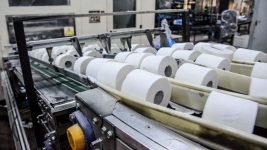
The Dirty Truth About Toilet Paper & PFAS Pollution
PFAS are a group of synthetic chemicals that are seemingly inescapable as they’re found in many common items– from non-stick pans to clothing, food packaging, and personal care products. Known as “forever chemicals” because they do not break down in the environment, PFAS pollute our soil, air, and water, posing a threat to the health of humans and natural ecosystems. And now in a recent study, researchers found PFAS are even in our toilet paper. They are polluting wastewater treatment systems and eventually making their way into our drinking water. PFAS have been linked to health issues such as cancer, reproductive concerns, and weakened immune systems.
PFAS in Wastewater
During an analysis of biosolids, or sewage sludge, a by-product of the wastewater treatment process, researchers at the University of Florida noticed concentrations of 6:2 diPAP, one type of PFAS. This chemical is commonly used in paper manufacturing when turning wood into pulp, leading researchers to investigate toilet paper as a potential source of PFAS pollution. The study collected 21 different kinds of toilet paper from across Europe, North America, South and Central America, and Africa and found PFAS in every sample.
The share of PFAS pollution from toilet paper in wastewater systems varies by region. Researchers estimate that toilet paper contributed just 3.7% of the 6:2 diPAP found in sewage sludge in North America, while the percentages were higher in Sweden (35%) and France (89%). The researchers note that their findings do not diminish the significance of toilet paper as a source of PFAS pollution in the U.S., but rather highlight that it is just one of many sources contributing to the issue – suggesting PFAS are present in a wider range of products in North America than in Europe.
The study considered average toilet paper usage by area, which can differ depending on whether people, say, dispose of toilet paper in a wastebasket or primarily use bidets. Those in the U.S. and Canada had the highest per capita toilet paper use.
Avoiding PFAS in Toilet Paper
Toilet paper makers add PFAS for a couple of reasons. For one, PFAS can help produce a fluffy and silky texture to toilet paper. This is particularly crucial for fancy brands that want to stand out for their deluxe products. Moreover, PFAS can ward off wetness and enhance the durability of the paper, which is ideal for shoppers who prefer sturdy and long-lasting rolls. However, some manufacturers are not even aware that PFAS are in their toilet paper.
The authors note that their research hasn’t investigated the direct health effects of PFAS absorption through the skin when wiping with toilet paper containing PFAS. Jake Thompson the lead author of the study told the Guardian, “I’m not rushing to change my toilet paper and I’m not saying that people should stop using or reduce the amount of toilet paper they use … The issue is that we’re identifying another source of PFAS, and it highlights that the chemicals are ubiquitous.” The study’s authors also found traces of PFAS in recycled toilet paper.
Avoiding PFAS in toilet paper may seem daunting, but there are some steps consumers can take to minimize exposure. One option is to look for organic toilet paper made from alternative materials, such as bamboo or sugarcane, which do not require the use of PFAS in their production. You might also consider alternative methods, such as using a bidet or a washcloth. Bidets are popular in many parts of the world, and they can be a more environmentally conscious option than toilet paper. If a bidet is not an option, using a washcloth or other reusable cloth might be a good alternative. Although it may require more effort and cleaning, it can significantly reduce waste and limit exposure to PFAS and other chemicals.
Addressing PFAS Contamination
Companies and regulators have yet to address the problem of PFAS contamination. The Environmental Protection Agency has been criticized for its slow response to the issue, and many states have taken matters into their own hands by setting their own limits on PFAS in drinking water. The discovery of PFAS in toilet paper highlights the need for greater regulation and oversight of chemicals used in everyday products. As concerns over the impact of these chemicals on human health and the environment grow, it’s increasingly important for consumers, manufacturers, and policymakers to take action to reduce their use and prevent their harmful effects.
creditSource link




